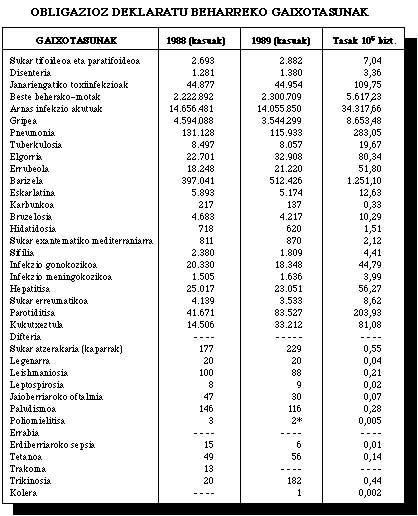Normal incidence of Od diseases in 1989
1990/12/01 Agirre, Jabier - Medikua eta OEEko kidea Iturria: Elhuyar aldizkaria
According to the Weekly Epidemiological Bulletin of the Ministry of Health and Consumption, the number of mandatory declaration diseases (SDGs) in 1989 remained within what can be considered normal incidence. Three were the diseases that exceeded the barrier of normality: pneumonia, chickenpox and parotiditis.
Intestinal infections Intestinal infections
In the group of intestinal infectious diseases, there are no significant changes with respect to last year's figures, but a fixity. In the case of typhoid and parathyphoid fever, however, there has been a slight increase (6.02% on average) in most Autonomous Communities. The exception was Cantabria, with a decrease of 75%. Also dysentery, in 1987 and 1988, at a notable decline, grew slightly in 1989 (6.65%), especially in Estremadura. On the other hand, food poisoning experienced no change compared to 1988, reaching 44,954 cases annually.
Respiratory infections and respiratory infections
The number of acute respiratory infections reported throughout the year was 14,055,850, representing a 5% decrease compared to the figures of 1988. As for the flu, the cases reported (3.544.299) decreased by 23% over the previous year. Cases of pneumonia have increased until 1988, but in 1989 they have suffered a decrease of 12.47%. The same happens to tuberculosis, which since 1987 is descending.
Exanthematic diseases
The year 1989 was an epidemic year for measles, with almost 33,000 cases reported. However, in 1986, in the previous epidemic year, the statement was much higher (220.109 cases). Although rubella descends, 2,972 cases have been reported more than in 1988. Chickenpox grows year after year from the 1970s to 512,426 cases in 1989, while demand drops for the third consecutive year.
Zoonosis Zoonosis
Of these ODG, only Mediterranean exanthematic fever suffered a boom in 1989 (98 cases more than last year); especially in the Balearic Islands, Castilla-La Mancha, Estremadura and La Rioja. The anthrax (137 cases), the brucellosis (4.217) and the hydaphidosis (620 cases) go down, although not significantly, but so the trend is maintained.
Sexually Transmitted Diseases (TSE)
Contrary to what could be imagined, the Bulletin notes that some TSE (such as syphilis or gonococcal infection) show a clearly decreasing trend in the last five years. The cases of 1989 (1809 and 18.348 respectively) show this decline. Melilla is the only one that has increased the rate of syphilis.
Others
The 1,636 cases of reported meningococcal infection exceed the figures of 1988, although they remain below the rates recorded at the beginning of the five-year period.
According to the National Center of Epidemiology, the declarations of hepatitis show a downward trend since 1986, and in this sense, the 23.051 cases declared in 1989 represent a decrease of 8.79% compared to those of 1988.
The same applies to rheumatic fever (3,533 cases in 1989), which has decreased in all autonomous communities except in Asturias (15,57%). In 1989, 80,527 cases and 33,212 cases were reported, respectively, as an epidemic year for parotiditis and cupola.
Among the ODG of low incidence, the year was without declaring any case difteri. But in the view of epidemiologists, we should not think that this disease has been eliminated, let alone. It should be noted, on the other hand, the important decrease in neonatal ophthalmos and cases of medieval sepsis, as well as the absence of cases of trachea. The cases of tetanus (apparently less than enough) were 56 more. Only three cases of cholera were reported: one declared in Salamanca (and brought from Turkey) and two others in Seville.
Finally, in 1989, rabies, exanthematic typhus, recurrent fever for lice, blowing, and yellow fever (forever?) disappeared. To mention.
SOURCE: Diseases of mandatory declaration. National Center of Epidemiology. Population used: Projections calculated by the Ministry of Health and Consumption.


Gai honi buruzko eduki gehiago
Elhuyarrek garatutako teknologia



